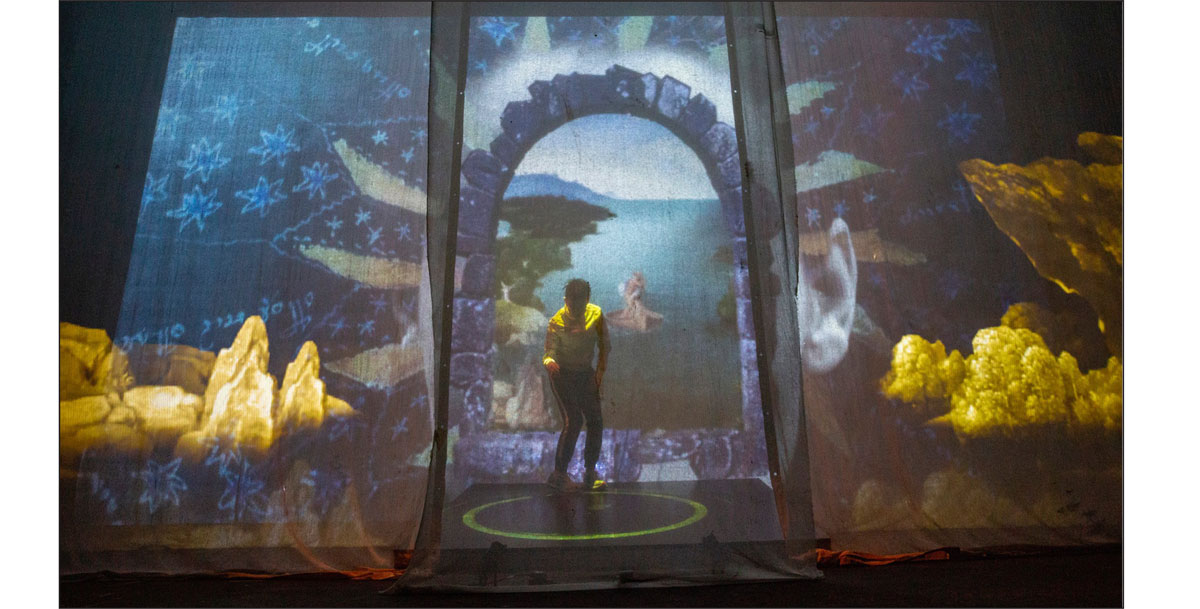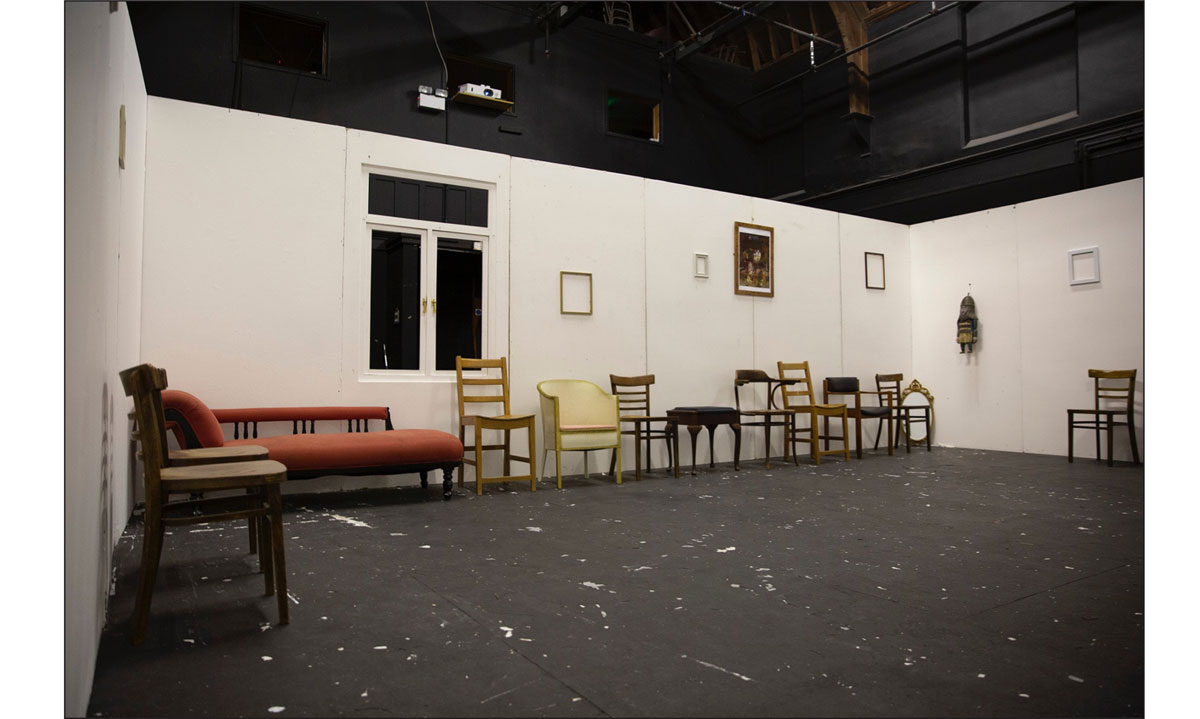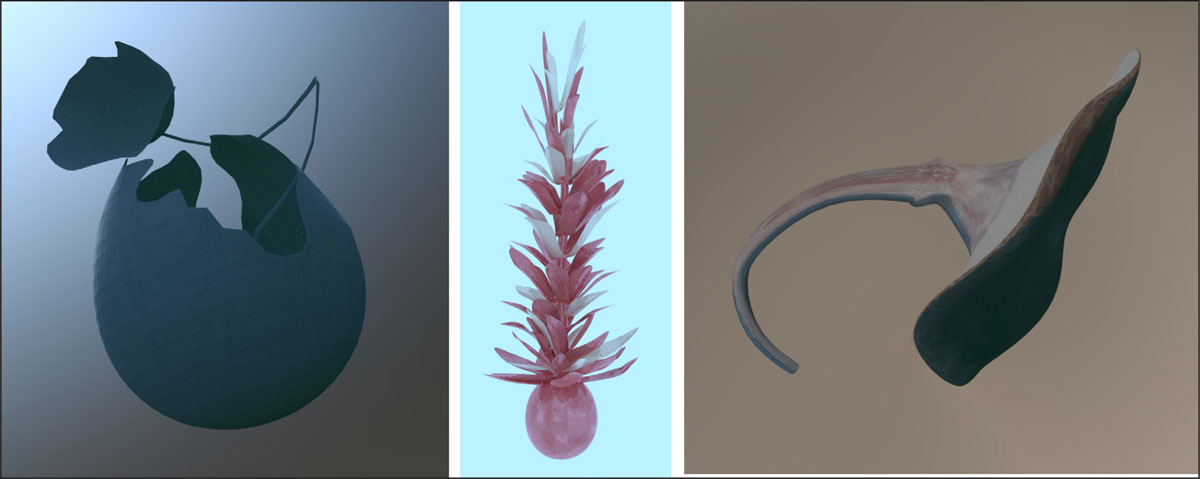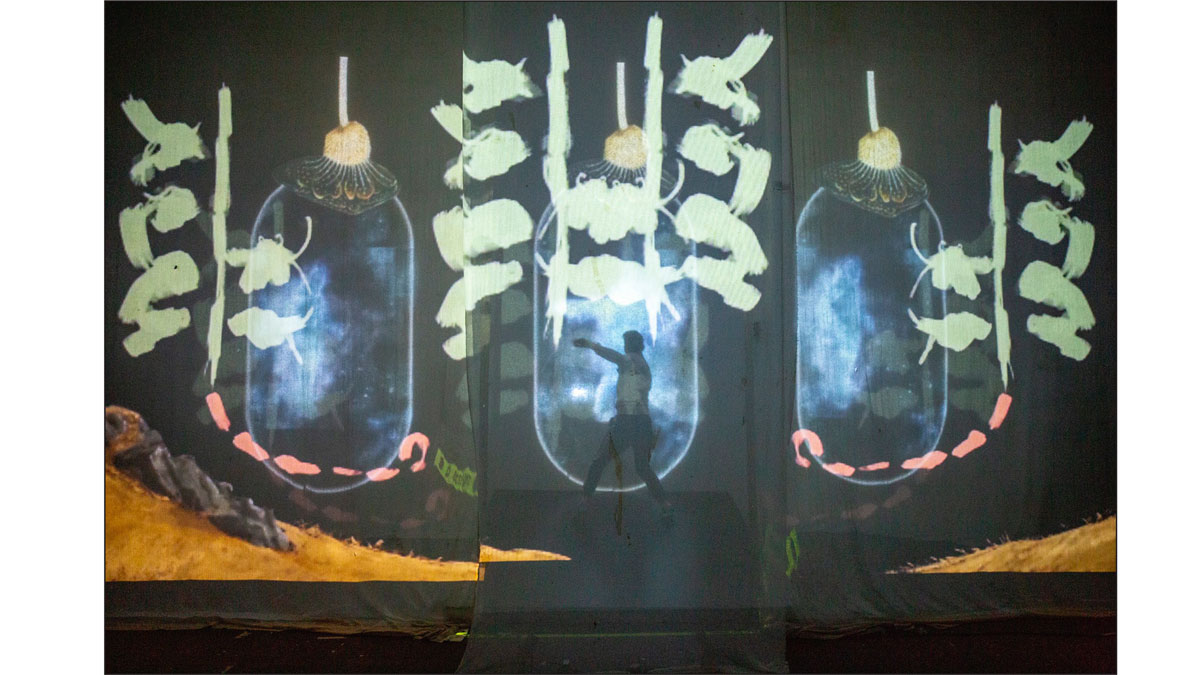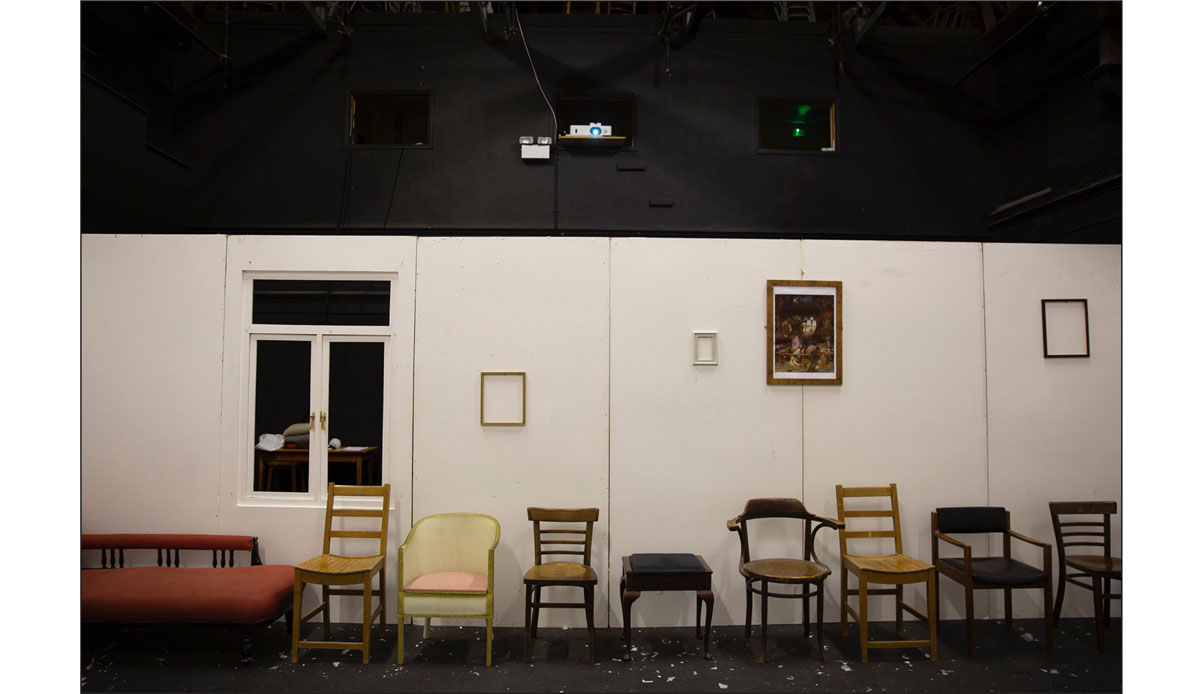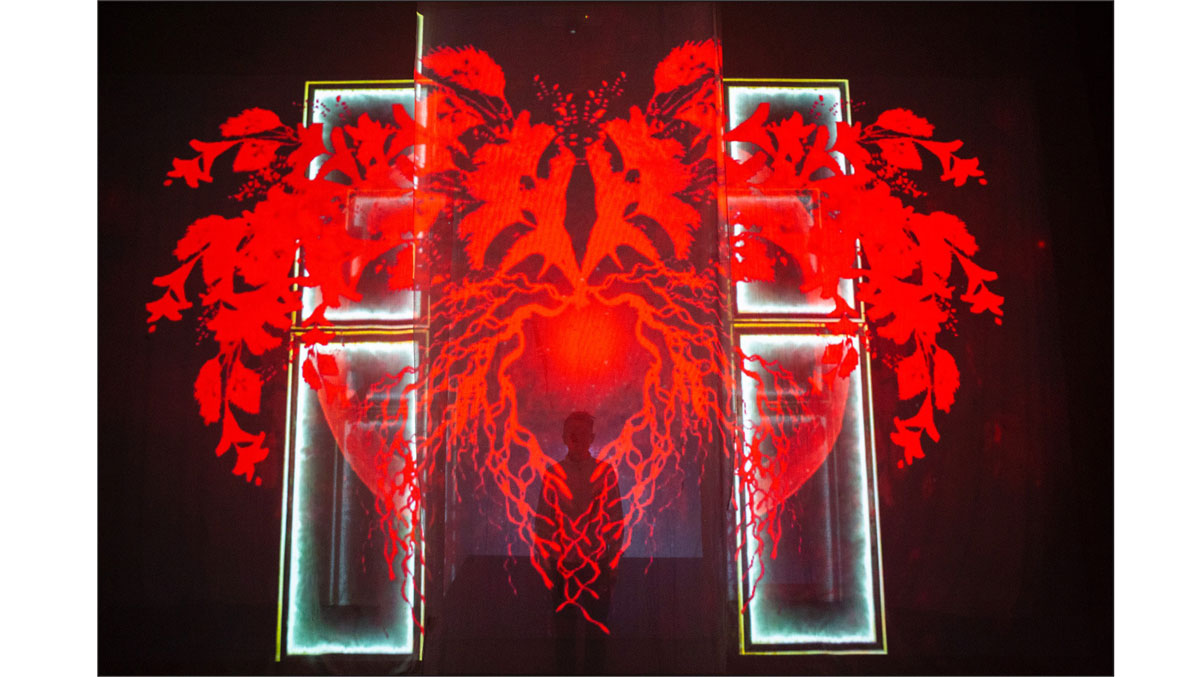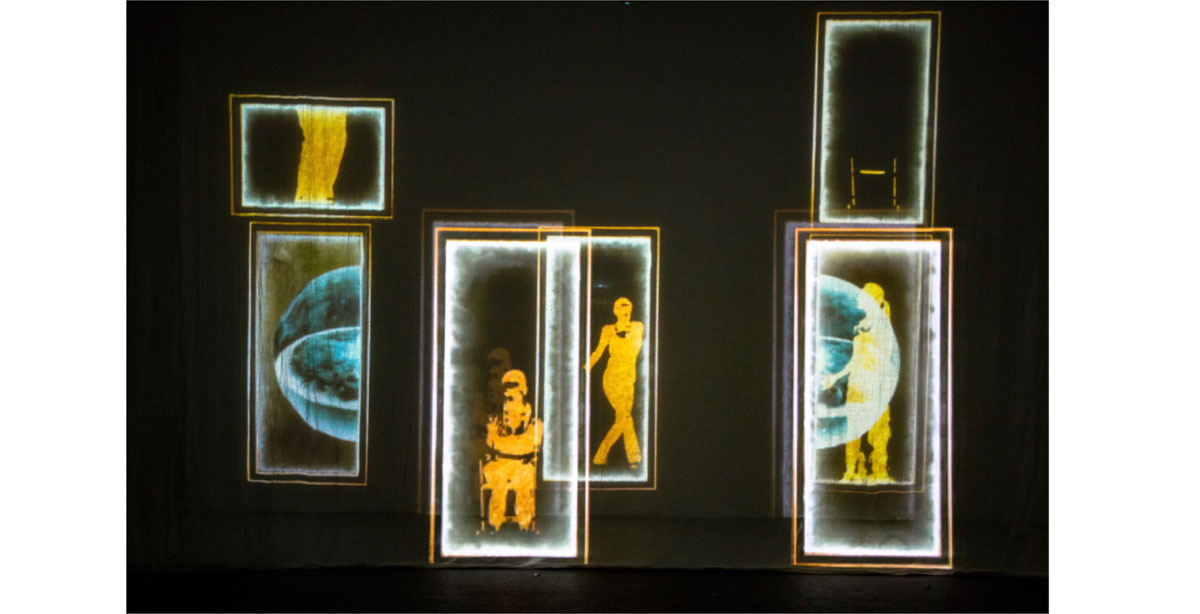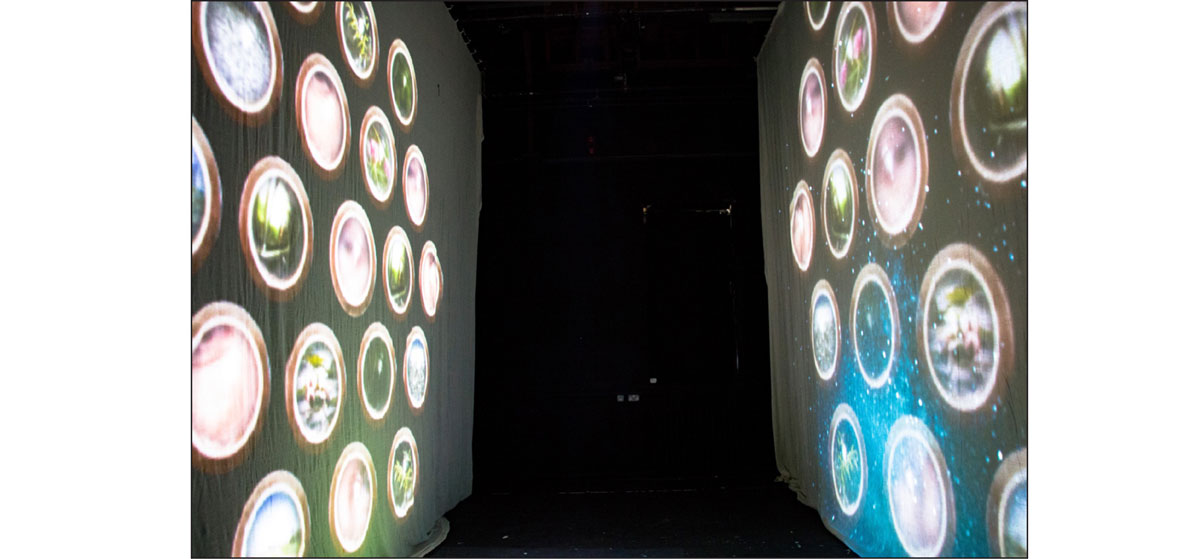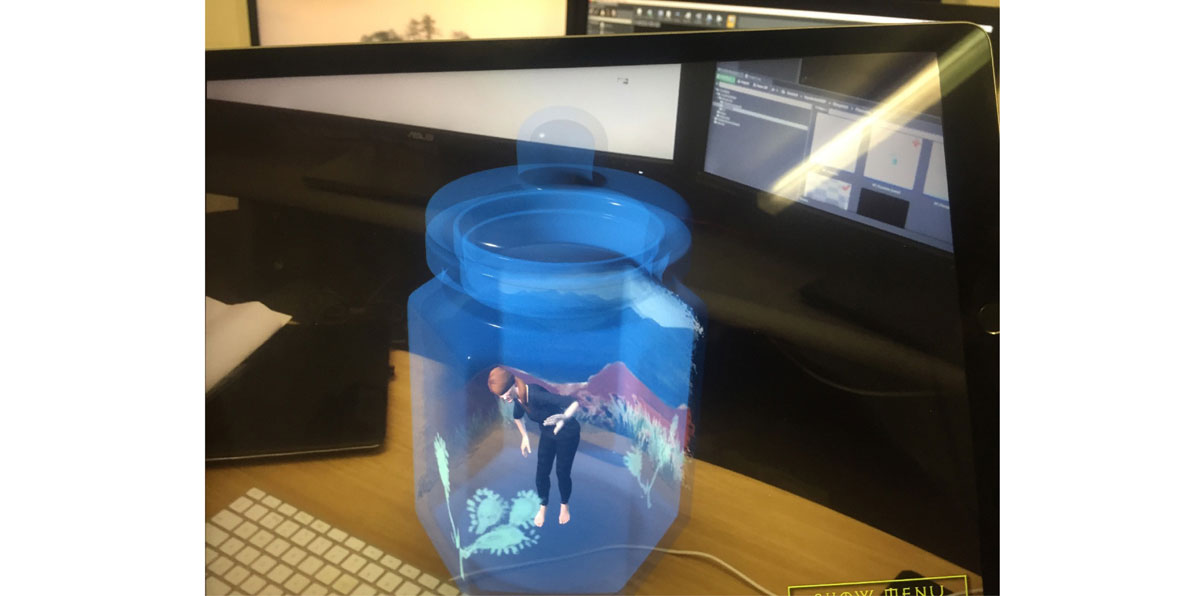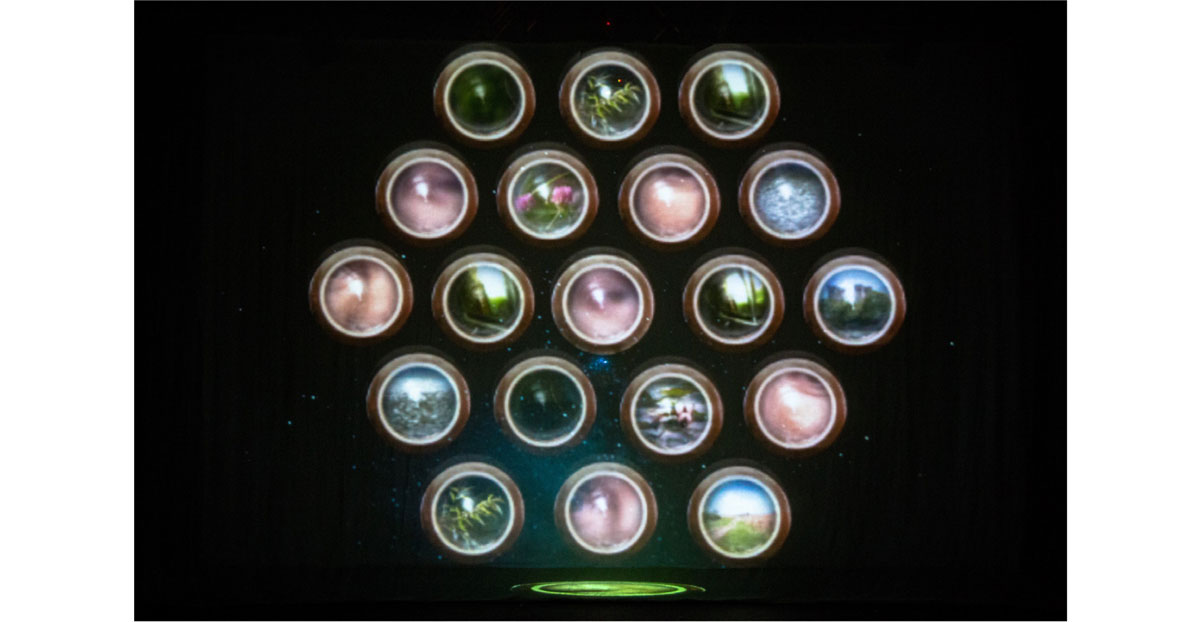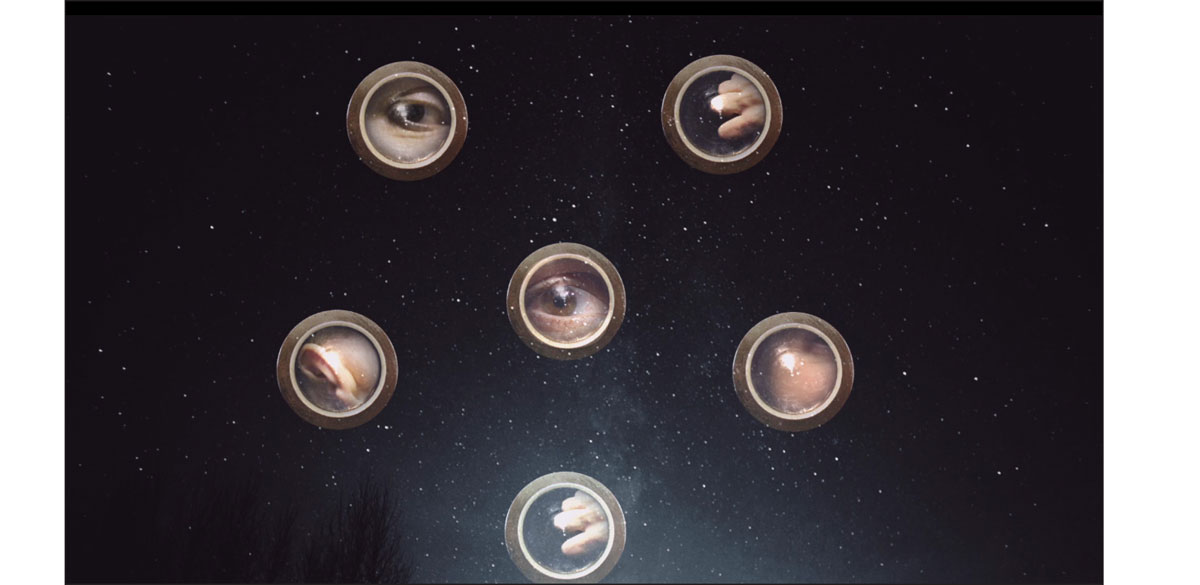In this article, we will discuss how Karen Barad’s concept of ‘diffraction’ (Barad 2014, 168) can be considered as a creative methodology, an intermedial techno-dramaturgical approach as suggested by Vlad Butucea (2022).1 We will explore this concept with reference to our practice-as-research project Our Lady of Shadows (2019). This was a work that combined dramatic text, physical performance, digital scenography, painting, animation, and music in an intermedial exploration of the tenuous pact between reality and imagination. We will look at various aspects of Barad’s concept and formulate a manifesto, a proposal for how it could inspire and shape a creative process. We will also frame the outcomes of our experimentation in the context of Katherine Hayles’ ‘posthuman condition’ as a way of exploring wider cultural and political implications of our inquiry.
The focus of our performance-as-research was on the role and effects of the intermedial apparatus, a multimedia performance design that as Chiel Kattenbelt and Freda Chapple have argued one can associate ‘with the blurring of generic boundaries, crossover and hybrid performances, intertextuality, intermediality, hypermediality and a self-conscious reflexivity that displays the devices of performance in performance.’ (Chapple and Kattenbelt 2006: 11). The use of intermedial aesthetics, and subsequently an intermedial apparatus, as a means for remediating a radio play was the main starting point for our practice-as-research inquiry. One of the interesting things which this intermedial apparatus enabled us to do was to externalise the imagination, to process the materials we had, uncover new layers, peel back, and discover new spaces and temporalities. It enabled us to challenge creative methodologies we were used to and move away from the need to reaffirm and revalidate habituated ways of thinking about performance composition. It also enabled us to challenge some fundamental understandings of the use of digital technologies in intermedial work, which scholars like Rachel Hann have described as ‘an exploitation of digital processes within the orientation and composition of sound-led audio-visual performance’ (Hann 2012: 61).2 It is important to state at this point that Barad’s concept of ‘diffraction’ and subsequently the concept of ‘diffractive dramaturgy’ was not a starting point for our methodology, nor did we always explicitly apply it throughout the process. It became apparent to us, however, that this methodology was implicit in what we were doing, hence this article will represent a review of the practice as research through this theoretical lens and the dramaturgical possibilities it offers.
Thus we will begin by outlining Barad’s concept of ‘diffraction’ which will be the main theoretical framework and context for our discussion of the use of technology in our practice-as-research case study.
In her article Diffracting Diffraction: Cutting Together-Apart, Barad defines the concept of diffraction as follows:
Diffract – dif-frangere – to break apart, in different directions (as in classical optics).
Diffraction/intra-action – cutting together-apart (one move) in the (re)configuring of spacetimemattering; differencing/differing/ différancing.
She begins her thinking about the concept of ‘diffraction’ by giving an account of mid-seventeenth century optical slit experiments, namely that of Francesco Grimaldi’s series of pinhole experiments. In those experiments Grimaldi observed that when light was shone through a pinhole the ‘boundary of the shadow [was] not sharply defined’ (Barad 2014: 170) and colored bands appeared near the pinhole rod. He concluded that the light did not behave accordingly to ‘known laws of ray propagation: reflection and refraction’ (ibid). This is very important since it establishes that the presence and agency of the technological apparatus is fundamental to the theoretical ramifications of the concept of diffraction. The apparatus directly influences the outcome of the experiment, and therefore is active and consequential in nature as opposed to a passive aspect of the event in question.
This account becomes a starting point for her developing an analytical methodology apposite for interrogating stable perceptions of the world. The methodology she proposes is fundamentally different from that of conventional academic critical reflection. Quoting Donna Haraway, she claims that diffraction does not produce ‘the same displaced, as reflection and refraction do. Diffraction is a mapping of interference, not of replication, reflection, or reproduction’ (Haraway 1992: 300). According to Barad: ‘[d]iffraction is not a set pattern, but rather an iterative (re)configuring of patterns of differentiating-entangling’ (Barad 2014: 168). In this methodology, the critiquing subject is always enmeshed and entangled within the material they seek to analyse, never distanced nor separate from it but always subject to an intra-active implication within it. As Barad puts it: ‘‘Humans’ are part of the world- body space in its dynamic structuration’ (Barad 2003: 829). She demonstrates that as an analytical methodology, her concept of ‘diffraction’ is conducive towards challenging and queering of binary dichotomies, destabilisation of dominant discourses, opening up of dynamic possibilities of interpretation, and a re-configuring of worlds through patterns of interference and multiplicities.
Our inquiry is whether this concept of ‘diffraction’ could also serve as a dramaturgical concept, a creative strategy for generating performances based on an interplay with a technological apparatus, and an exploration of the role of digital technology in this process and its consequences. It is also worth noting that as we consider ‘diffraction’ as a dramaturgical concept we will be departing from the commonly understood concept of dramaturgy, one that could be defined as a ‘set of techniques/theories governing the composition of […] the performance text’ (de Marinis 1987: 100) where the use of technology may be subsumed and subservient to overarching dramaturgical structures. The main reason for this is to challenge the inherent compositional hierarchies within traditional approaches to dramaturgy which in turn structure and stratify the representation of knowledge and cultural experience. Through our exploration of the application of the concept of ‘diffraction’ to the creative process we will also challenge critical perspectives such as those put forward by Juhani Pallasmaa that the use of digital technology in intermedial theatre generates a mere ‘passive visual manipulation’ (Pallasmaa 2005: 12) or as Arnold Aronson claimed that it creates a disembodied ‘theatre about the new technology’ and not ‘a theatre created as a consequence of the new technology’ (Aronson 1999: 193). Part of what transpired from our practical explorations is that the use of a technological apparatus in performance is indeed rather consequential and conducive towards an embodied aesthetic, an aesthetic where the ‘live’ presence of the performer is made manifest through a juxtaposition with digital scenography and becomes a way of engaging the audience with the piece. Barad’s concept of ‘diffraction’ also helps us to think about the role of technology in this context.
In the final section of this article, we will explore the wider cultural and political implications of this project by framing it through Katherine Hayles’ concept of the ‘posthuman’. In her book How We Became Posthuman: Virtual Bodies in Cybernetics, Literature, and Informatics (1999), Hayles defines the ‘posthuman point of view’ in terms of key assumptions about: informational patterns, consciousness, the human body, and the human relationship to technology. These assumptions (perspectives) put forward by Hayles, will form the basis for a discussion about how the engagement with technology in our project resonates with and critically addresses the paradigms of posthumanism.
Introduction to the project
In this section, we will introduce the project by offering a brief synopsis of the original play, and a description of the design of the two current forms of the project. Currently, the project has two forms, an intermedial theatrical version of Lucy’s radio play Our Lady of Shadows (broadcast on BBC Radio 3), which is a radical adaptation of Alfred Tennyson’s famous poem, ‘The Lady of Shalott’ and an augmented reality version of the radio play which also functions as its documentation.
Set in the medieval period, the play’s protagonist, Catherine, is a young girl raised in a convent by nuns. At the beginning of this story, she has become wilful and determined to gather knowledge. So, the nuns imprison her in a tower. Her only access to the outer world becomes the flickering images of a camera obscura, which she built herself. From those images that she sees in the camera obscura, she desperately attempts to paint an illuminated manuscript, a record of the world outside that she cannot be a part of. As time passes her incarceration weighs heavy on her and the colours of her illuminated manuscript are replaced by her own ‘shit and blood’. Into this mad scatological world, a golden knight appears, the ‘ultimate chivalrous’ medieval knight, who in the final subversion of the Tennyson poem is killed, attempting to rescue her. At which point she dresses him in her clothes and sends him down the river in a boat to Camelot. The play ends with her putting on his armour and riding out to circumnavigate the world.
Intermedial theatrical version
The first form of the project that we developed was an intermedial theatrical version that was performed in Aberystwyth Castle Theatre in 2019. The staging consisted of two screens set up in parallel, a back screen for a back projection and a front screen for a front one. The back screen was made of solid cloth and the front screen was made of a see-through gauze.
The front screen also had an opening, a strip of gauze through which the performer could pass. The space between the two screens was the performance area and had a floor projection onto a wedged ramp. Beyond the gauze screen, there was the audience space. This was a white room encompassing the front gauze screen. The audience had a choice to sit or stand up and walk around the room spectating the show as if it were an installation. The spatial set-up made that invitation.
Due to its towering quality, this technology laden scenographical design gave a sense of the performer being trapped between the two screens, as if between two parchments of an illuminated manuscript. It also metaphorically represented an anchor hold, a space of confinement and imprisonment, albeit a porous one. The projected images were a mixed medium digital scenography a mixture of animations, scanned paintings, drawings, videography, and 3D graphics.
The main dramaturgical logic of the intermedial staging was to bring all these layers of intertexts and media together with live performance through a technological apparatus and a multi-layered production pipeline. As such our approach to design was similar to the work of companies and practitioners such as Katie Mitchell, Robert Lepage, Imitating the Dog and Builders Association, which often centers on the juxtaposition of the live and mediated performance.
Augmented Reality (AR) version
The augmented reality version of the project was a response to the TaPRA 2018 conference gallery call held in Aberystwyth, Wales. The call was to present documentation of a practice as research project within the thematic context of the gallery, which was one of agriculture, the regional context of Aberystwyth. One of the suggestions was to present the documentation in a jar, so we decided to present the project in an augmented reality jar, that could be ‘placed’ anywhere in the gallery space by using an iPad app. When activated the experiencer could spectate 3D renderings of two scenes from the piece, from different angles, and place objects from Catherine’s paintings in the augmented reality space, effectively enabling them to paint the gallery space around them with virtual objects from the performance.
Diffractive Dramaturgy Manifesto
Having contextualized the theoretical framework and our project we will now consider how Barad’s concept of ‘diffraction’ could also serve as a dramaturgical concept, a creative strategy for generating intermedial performances based on an interplay with a technological apparatus and an exploration of the role of digital technology in this process. We will consider this by proposing a manifesto for a ‘diffractive dramaturgy’, a series of postulates based on Barad’s theories that will form the basis of a critical conversation about the role of technology in our project. We chose the format of a conversation since it is more conducive towards a multi-perspectival discussion and one that is arguably more ‘diffractive’, where the authors are more explicitly implicated in the discussion. We will begin with a key concept, which we believe lies at the heart of her ‘diffractive methodology’, namely the concept of the apparatus.
I: A dramaturgy of the posthuman apparatus
Lucy: The first question to ask here is how can we think of dramaturgy as an apparatus, a means of constructing theatre through a technological apparatus, and specifically in our inquiry a posthuman one?
Piotr: Theorising theatre as an apparatus or even a machine is not new. One interesting theoretical starting point which resonates with our inquiry comes from Jean-Francoise Lyotard. Lyotard saw theatre as a technological machine, ‘a theatrical representational apparatus’, ‘one that works to construct and manage particular regimes of space, time and objects, so that they can become instruments for use’ (Quick 2009: 32).
He critiqued theatre as a hierarchized space, with a hierarchized relationship between the stage and the auditorium which he called ‘limit 1’ and a hierarchized relationship between the inside and the outside, the theatre, and the exterior world it seeks to represent, which he called ‘limit 2’. He outlined an organizational principle for theatre and then deconstructed it, nonetheless, his critique focused on the fact that this apparatus is rigid, authoritarian, insular, and fairly stable. It must strive to be so, he argued, to maintain a stable representational world. Thus, in many ways for Lyotard, the model of theatre aspires to be a static arrangement.
Barad’s concept of a diffractive apparatus which we would like to consider differs from what Lyotard proposes. She argues: ‘apparatuses are not mere static arrangements in the world, but rather apparatuses are dynamic (re)configurings of the world, specific agential practices/intra-actions/performances through which specific exclusionary boundaries are enacted’ (Barad 2003: 816). She then expands this to consider multiple apparatuses: ‘[f]urthermore, any particular apparatus is always in the process of intra-acting with other apparatuses, and the enfolding of locally stabilized phenomena’ (Barad 2003: 817).
This resonates with the intermedial setup and implementation of technology in our project in many ways. The intermedial setup with the three projections is an apparatus through which the radio play is diffracted; the very dramaturgical concept of the camera obscura is a technological apparatus as well. The Augmented Reality app is also a technological apparatus that diffracts the play and entangles the participant and their experience of the virtual and actual space. All these different apparatuses intra-act with each other and are entangled and implicated, like boxes within boxes or a set of Russian Dolls. They constitute a recursive intra-active mise-en-abîme.3 A recursive journey into the abyss.
Lucy: This way was very apparent when transcribing the audio drama into the digital form. I think immediately you see that the apparatus does something different, it starts to diffract things in an interesting way. So, I think we can argue that the apparatus is dynamic and (re)configuring what we are doing. The way that audio is constructed transfers interestingly to digital because both of them are being fed through an apparatus, when you’re writing audio drama, you’re feeding it through an apparatus of the microphone, through a speaker, through the ear, into the brain. And when you change that to a diffractive apparatus, which is intermedial, using the lens and projected images, it carves the same space in the universe, but differently.
Piotr: How did this transfer re-configure the world of the play?
Lucy: It reconfigured the way that the imagination of the audience works, because obviously if you’re painting those pictures inside your head, your skull becomes the proverbial cave. And so, you see those things in a particular way. When it’s filtered through your designer’s imagination, you’re bringing something different to it because it’s no longer each person imagining their own world. The visual dramaturgy builds upon a multiplicity of layers, reconstructions of Bosch’s paintings, the Voynich manuscript, visualisations of images from the script, dance videography, etc. It gives us a box within a box within a box. And that for me is where navigations, and negotiations happen. This methodological approach became evident and emerged throughout the devising process of the piece.
Piotr: Are there specific examples in the piece?
Lucy: I think the scene when Catherine is painting. Because we’ve got my imagination as the writer, your imagination as the designer, and the images that you create. And we’ve also got the character of Catherine and what she is painting. So, what we are trying to do with the intermedial production was to encourage the audience to experience Catherine painting those images.
Piotr: Barad further argues that an apparatus allows for an enactment of ‘exclusionary boundaries’ (Barad 2003: 816) and a blurring and destabilisation of hegemonic binary oppositions. I was wondering if there was a connection here with the impetus to write a feminist critique of Tennyson’s poem in the radio play and subsequently transfer that to the intermedial version.
Lucy: In Tennyson’s poem, the rhythm, the form, is very rigid, forceful, and very constraining. The audio drama is deliberately written in a rhythm that fights that all the time. And I think that the intermedial apparatus expanded on this. By adding different layers, and different perspectives, we were able to stage the exclusionary. Not so much as a diffraction of binary oppositions, but rather as multiplicities that can expand and offer different meanings and interpretations. This aspect of a ‘diffractive apparatus’ was evident in the original radio play but became even more explicit in the creative process of making the intermedial piece.
Piotr: The intermedial apparatus we used also reconfigured the audience/performer relationship spatially in the theatrical version. In the theatrical version, the audience was placed in a constructed room separated from the performance area by a gauze that was open and allowed for a passage between the audience space and the stage. In that sense ‘the hierarchized relation of stage and house’ (Lyotard in Quick 2009: 32) that Lyotard defined as ‘limit 2’ was diffused and made porous. This was also the case with limit 1, ‘the hierarchized relation of inside and outside’ (Lyotard in Quick 2009: 32).
II: A dramaturgy that is not reflective
Lucy: As previously mentioned, in her writing, Barad posits the concept of ‘diffraction’ as one that is neither reflective nor refractive, in fact, it is opposite to notions of reflexivity or distanced critical reflection. In this context, Barad quotes Haraway saying:
Diffraction does not produce ‘the same’ displaced, as reflection and refraction do. Diffraction is a mapping of interference, not of replication, reflection, or reproduction. A diffraction pattern does not map where differences appear, but rather maps where the effects (disruptions, and destabilisations) of difference appear. (Haraway 1992: 300)
Piotr: By following the concept of ‘diffraction’ we can move away from a compositional logic which tries to map the text onto a theatrical performance, the conventional page-to-stage logic which reflects the world outside. Instead, we can use intermedial technology to create the effects of mappings which essentially becomes a dramaturgy of disruptions and destabilisations. When considering Barad’s concept of diffraction as a way of structuring the implementation of technology in performance one can contest classical scientific approaches to dramaturgy such as those that inspired Zola and Stanislavsky amongst others.
Lucy: Initially when working with this technology I had an instinct as a director to get the balance right in terms of the scale of the images, of the words in the text, and their relationship to the imagery. This almost echoed the process of mapping that Haraway talks about. But at some point, we accepted the diffraction that was happening, and we stopped trying to get the balance right and ended up with a tiny performer, massive images, and much of the text out of joint. We ended up with dispersed imagery and at times floating and disconnected text. And this has the potential to make the audience think very differently about what they are seeing and hearing.
Piotr: Yes, it reminds me of Robert LePage’s notion of ‘metissage’ and ‘decalage’ (Lepage in Pluta 2010: 194), a coming together and a falling apart of the different components of an intermedial mise-en-scene. An intermedial staging that is always in flux, without an impetus to reflect the world outside but to disperse it and thus challenge an imposition of a discursive dominant perspective, as you said allowing the audience to think through the material differently.
III: A dramaturgy that is based on a re-configuring of the world
Piotr: As Barad put it: ‘making knowledge is not simply about making facts but about making worlds, or rather, it is about making specific worldly configurations’ (Barad 2007: 98). I felt that our whole process was based on a constant re-configuration and layering and re-layering of materials and technology. And in that, it was an attempt to re-configure knowledge, through a diffracted intermedial apparatus, through the various layers of intertextuality both in terms of text and imagery and live performance.
Lucy: Yes, and the apparatus of the camera obscura, enabled me as an audio writer to convey the world outside of the tower that Catharine constructs in her paintings. What is important here, is that she is talking about everything being restricted. She keeps on re-configuring the world out there into her continual incarceration because that is her ‘local’ world. This again echoes Barad’s thinking where she states that the ‘local semantic and ontological determinacy are intra-actively enacted’ (Barad 2003: 820). The local world of her tower is intra-actively reconfigured through the intermedial apparatus.
IV: A dramaturgy of interference
Piotr: Barad claimed that ‘the ‘past’ and the ‘future’ are iteratively reworked and enfolded through the iterative practices of spacetimemattering’ (Barad 2014: 181).
Lucy: This notion of past and future being entangled and reworked reminds me of a moment in the piece, when we see a woman sitting on a chair in a floating painting frame projected onto the gauze, with other painting frames behind them and actions taking place within them. One action or one event would trigger another. They seem to interfere and diffract each other throughout the layers of the projections. Again, this disrupts any sense of just looking at one framed thing, one sense-making-frame, at one character or temporal dimension. As a spectator one is encouraged not to expect one perspectivist focus all the time.
V: A dramaturgy of indeterminacy
Piotr: Barad states that ‘diffraction troubles the very notion of dichotomy’ (Barad 2014: 168). In relation to that, I always thought that the very figure of the hermit that Catharine in the play embodies and indeed the spatiality of the ‘anchorhold’ that she inhabits, are indeterminate concepts and arguably diffractive in nature. In Posthuman Spiritualities in Contemporary Performance, Silvia Battista discusses the figure of the hermit and the anchorhold as exemplifying a paradoxical blurring of the dichotomies of the ‘open space of the outside world, and the enclosed space of the cell’ (Battista 2018: 104). To elaborate further on this paradox, we can consider the figure of the hermit and its relationship to the notion of the desert. In Greek eremites means ‘person of the desert, from eremia desert, solitude, from eremos uninhabited’ (1988 Chambers Dictionary of Etymology in Battista 2018: 105). This points to a paradoxical duality between the physical enclosure and solitude of the hermit instantiated by the desert and the open expanse and the vastness of the very desert itself. David Jasper terms this as ‘a coinsidencia oppositorum’ (Jasper 2004: 6) – a conjunction of opposites.
Arguably we managed to ‘trouble’ this dichotomy in our practice through a diffractive dramaturgy. This was evident in the intermedial staging and the way the scenographical design challenged the binary divide of the notions of outside/inside. There was the ‘porous’ gauze for front projection, which opened the inner space of the ‘anchorhold’, represented by the space in-between the two projection screens and the rest of the theatre- and by extension the outside world, the open vastness of the ‘desert’ which was also augmented and brought into the apparatus through the camera obscura projection. Again, we set up a multilayered diffractive apparatus here.
Lucy: This indeterminacy is one of the things that drew me to the possibility of this sort of presentation. Audio offers endless possibilities to destabilize and unsettle and so challenge perceptions, because of the power of the unseen. It seemed to me that in a different way this form also offered the potential to play with an indeterminacy. And although of course we are working with images, so it is not unseen in the way audio is (until it is conjured through the airwaves via words sounds, etc.) the haptic contradiction of the fact we see and yet cannot touch these images (reminiscent of the phantom limb sensation) together with the fact that the images can be layered upon each other numerous times in a way audio also does so well, offer a similar dislocation. This multilayering is one of the ways in which the space is carved out in audio its depth discovered and here I feel it is offered as well. There is also the presence of that liminal space, and the bleeding of the inside and outside which are always used to great effect in audio. Can also work here but with an even greater extent since we have the physicality of the performer breaking boundaries as well as disappearing and being absorbed much in the way Barad describes.
Piotr: Likewise, the diffractive dramaturgy of the AR application also troubled this dichotomy and placed the experiencer in a liminal space between the actual and the virtual. This navigation created a diffractive participatory dramaturgy that was both embedded within the material experience (spectator montaging/framing their experience) and the virtual digital dimension (montaged and edited 3D cutscenes). This echoed what Gilles Deleuze said about virtual and actual images that are ‘Distinct but indiscernible…in continual exchange’ (Deleuze 1985: 68). Also, what Mathew Causey suggested, that the interstice between the virtual and the actual forms ‘zones of indistinction as indiscernible phenomena’ (Causey 2016: 434). Arguably the experiencer was placed in a zone of indistinction, they were both inside and outside the world of the piece, traversing this polarity, experiencing the material and digital spatiality simultaneously. They were offered an inner psychological world, which then manifested itself as both digital and material. Thus, Catherine’s solitude became a diffraction of her inner psychological world and the expanse of the world outside.
VI: A dramaturgy of multiplicities
Lucy: Barad conceptualises diffraction not as a ‘singular event that happens in space and time’ but a ‘dynamism that is integral to spacetimemattering. Diffractions are untimely. Time is out of joint; it is diffracted, broken apart in different directions, and non-contemporaneous with itself. Each moment is an infinite multiplicity’ (Barad 2014: 169). A dramaturgy that would respond to the above notions of time and space would embrace multiplicities and simultaneities in its composition.
Piotr: In many instances, I feel that the intermedial piece dispersed perspectives. This was evident in one of the scenes where the projection of the camera obscura floated from the singular image on the ground and split into multiple camera obscuras and a multiplicity of images conveying the outside world. This multiplicity offered several diffractions of the outside world both instantiated temporally and spatially. This in turn offered multiple possibilities for interpretation, challenging a singular perspectivist framing. This become a dramaturgical strategy to instantiate as Barad puts it a ‘field of possibilities [that was] not static or singular but rather […] a dynamic and contingent multiplicity’ (Barad 2003: 819).
Lucy: And I think there’s something else along these lines. I don’t think that here Catherine is one person. I think that the sense of oneness is diffracted, Catherine is multiple people, but also so is the audience, multiple people, and I think that this troubles the sense of locale and isolation, and oneness is lost, but something else is replaced by it. The intermedial dramaturgy again ruptures the possibility of a singular dramatic character perspective here. As Jennifer Parker-Starbuck stated, the coming together of human and technological in performance can create ‘ruptures in universalizing ‘human narratives, giving us pause and provoking our imagination’ (Parker-Starbuck 2011, 195).
Kathrine Hayles’ the ‘Posthuman Condition’
When thinking about the posthuman condition we would argue that the intermedial and AR versions transformed Catherine into a posthuman character. Basing our reflections on Kathrine Hayles’ theory of the posthuman, in this final section we would like to explore how the diffractive dramaturgy effectuated this transformation. Hayles’ theories offer a robust foundation for contemplating the posthuman aspects inherent in our project. Furthermore, they poignantly align with the historical context in which the original play text was written, hence offering a good insight into the posthuman condition that Catherine inhabits.
Lucy: In her book How We Became Posthuman: Virtual Bodies in Cybernetics, Literature, and Informatics (1999), Katherine Hayles defines the ‘posthuman point of view’ in terms of key assumptions about: Informational patterns, consciousness, the human body, and the human relationship to technology.
I
In terms of the informational patterns, she claims that they are ‘privileged over material presence, so that biological embodiment is not viewed as a fixed and immutable origin or destiny of life but rather as an ‘accident of history’, as contingent and subject to creative mutation’ (Hayles 1999: 2).
Piotr: I think that this was quite often the case within both iterations of the piece, the theatrical one, and the AR version. The scale of the spectacle diminished the live human figure on stage and Eddie quite often had to ‘battle’ with the digital elements of the spectacle to negotiate her presence. As such Catherine’s existence was constantly compromised by the fictional fantasy world that would take precedence in defining her identity, her motivations, and general state of existence. She was literally trapped within the digital layers of the piece and also scenographically the material performer Eddie was trapped between the projection screens, spaces of the virtual ‘informational patterns’.
Lucy: She was lost in the informational patterns to a certain extent, but she was not effaced completely because she is flesh and blood, and the ‘live’ body is always a site of resistance. Also, the effacement of materiality of the performer never occurred in the radio play, she was never posthuman in the radio version because of the listener’s perspective of being inside her head, and what is encouraged in the audio drama is empathy. She became a posthuman when we shifted the perspective by ‘diffracting’ the radio play through the intermedial apparatus.
II
Piotr: Another aspect that of the posthuman condition that Hayles talks about refers to the notion of consciousness and identity. According to Hayles, consciousness, widely understood as the locus of human identity, is viewed as an ‘evolutional upstart trying to claim that it is the whole show when in actuality it is only a minor sideshow’ (Hayles 1999: 3). I think Hayles touches here upon externalism, the fact that our identity is becoming progressively externally constructed in contemporary society. Barad advocates that diffractive thinking can challenge discourse by troubling and externalising a subject-object relationship. Again, I think this was evident in our dramaturgical approach since the outside world, the world of the camera obscura incurred upon and diffracted Catherine’s inner world and that of the live performer.
Lucy: In this audio drama it is total consciousness, which ties in with the audio drama apparatus, takes us through the ear into the brain, and in this case takes us into Catharine’s head, and therefore into her consciousness. In the audio drama, the diffraction happens inside her head as she constructs the world around her. And this is a huge difference from the intermedial version, where there is a shift of consciousness from the individual-centred perspective to a diffracted posthuman external mindscape.
III
Hayles argues that the posthuman view constructs the human being so that it can be ‘seamlessly articulated’ with intelligent technology. The posthuman subject rejects the ‘natural’ self, having become a composite, ‘an amalgam, a collection of heterogeneous components, a material informational entity whose boundaries undergo continuous construction and reconstruction’ (Hayles 1999: 3).
Lucy: What was required of us when working with this technology was a search for the slippages between the boundaries of the human and the technological. When we found moments of slippages in the fringes between the performer and technology, the ‘composite’ the amalgam Hayles speaks of became evident. We encouraged a different perception of reality, and a different subjective position. There is a scene in the piece where in the projections Catharine’s gold-leaf-saint avatars slip in and out of moving painting frames, re-configuring and rearranging them, summoning them and pushing them away. Her avatars multiply but essentially, she becomes a collection of heterogenous components.
Piotr: Thinking again about the dramaturgy of the AR app where arguably the perception of the ‘natural self’ is challenged, I felt that the experience of the AR app foregrounded what Franco Damasio termed as ‘the homeostasis of perception’ (Damasio 2000). Homeostasis of perception is a state where all the aspects of our perception (visual, aural, proprio sensory perception, etc.) function seamlessly and are integrated coherently within a stable perception of the everyday. This conceals the fact that what constitutes perception is a complex multimodal construct of which we are not aware on a daily basis. Following what Hayles said, by engaging with the app performatively the experiencer became aware of the composite nature of their perception and became a ‘composite’ themselves. An amalgam of the material self and technology, performatively traversing the boundaries in a constant process of construction and deconstruction. In that sense, the project also exemplified Parker-Starbuck’s concept of ‘cyborg theatre’, a theatre that explores human subjectivity in a posthuman world ‘through the integration of bodies and technology’ (Parker-Starbuck 2011: 6).
Conclusion
In this article, we discussed how Barad’s concept of diffraction can be considered as a creative methodology with reference to our practice-as-research. We looked at various aspects of this concept and formulated a manifesto, a proposal for how it could inspire and shape a creative process. We believe that this methodology could enable contemporary theatre practitioners to consider the intermedial setup as an experimental apparatus. An apparatus that can be conducive towards the queering of binary dichotomies, destabilisation of dominant discourses, opening up of dynamic possibilities of interpretation, the re-configuring of worlds through patterns of interference, and iterative re-workings of ‘past’ and ‘future’. We also framed the outcomes of our experimentation in the context of the posthuman condition, following Hayles’ theories. Based on what we did we feel that there is an argument to be had around the concept of a ‘diffractive dramaturgy’ as a techno-dramaturgy, and its application in contemporary intermedial performance practice. This is because it encourages a mode of experimentation, based on a technological apparatus in the case of our research, one that enables diffractive thinking, a re-configuring of our worldviews, so like Catharine, we peer through a lens onto the potential for another reality.
Notes
- Butucea, Vlad (2022) ‘A ‘diffractive methodology’ for the study of digital performance’, TaPRA 2022 University of Essex conference paper. [^]
- Hann talks about ‘digital opera’ specifically here, but this perception applies to most forms of intermedial practice. [^]
- Mise-en-abîme is a literary and artistic term derived from French, which translates to ‘placed into abyss’ or ‘put into the abyss’. Mise-en-abîme refers to a self-referential technique where a work contains a smaller version or representation of itself within its own structure. This recursive or nesting effect creates layers of meaning and often serves to explore themes of reflection, self-reference, and the infinite regress of representation within the work of art. [^]
Competing Interests
The authors have no competing interests to declare.
Author Information
Lucy Gough
Dr. Lucy Gough is a Creative Research Fellow at Aberystwyth University. She has written extensively for TV, Radio and Stage for over 20 years. In 2010 she was awarded a ‘Granada artist’ writing residency in California for three months. She has also been awarded a Creative Wales Award by the Welsh Arts Council. She was a finalist for the BBC Wales Writer of the Year Award 1994 and the BBC Wales Drama Award 2012 and the Nick Darke Award 2013. Most recent productions include GLADHEARTS ADVENTURING for Theatr Clwyd and Powis Castle (National Trust) staged 2019 – 2020. Company of Sirens recently produced 2019–2020 THE WOLF TATTOO and commissioned and produced THE CREATURE. Many of the plays have been published.
Piotr Woycicki
Dr Piotr Woycicki is a Lecturer in Theatre and New Media at the University of Aberystwyth. His research interests concern the intersections between political and aesthetic theory and contemporary intermedial performance practice. He is the author Post-cinematic Theatre and Performance (Palgrave Macmillan 2014) and has published in various academic journals. His practice-as-research encompasses music composition and digital scenography design.
References
Aronson, Arnold 1999 Technology and dramaturgical development: Five observations. Theatre Research International, 24: 2, pp. 188–97. DOI: http://doi.org/10.1017/S0307883300020812
Barad, Karen 2003 Posthumanist Performativity: Toward an Understanding of How Matter Comes to Matter. Signs Vol. 28, No. 3, Gender and Science: New Issues, pp. 801–831. DOI: http://doi.org/10.1086/345321
Barad, Karen 2014 Diffracting Diffraction: Cutting Together-Apart. Parallax, 20:3, pp. 168–187. DOI: http://doi.org/10.1080/13534645.2014.927623
Battista, Silvia 2018 Posthuman Spiritualities in Contemporary Performance. Cham: Palgrave Macmillan. DOI: http://doi.org/10.1007/978-3-319-89758-5
Butucea, Vlad 2022 ‘A ‘diffractive methodology’ for the study of digital performance’. TaPRA 2022 University of Essex conference paper.
Causey, Matthew 2016 Postdigital Performance. Theatre Journal Vol. 68, No. 3, pp. 427–441. DOI: http://doi.org/10.1353/tj.2016.0074
Chapple, Freda and Chiel Kattenbelt, eds. 2006. Intermediality in theatre and performance. Amsterdam: Rodopi. DOI: http://doi.org/10.1163/9789401210089
Damasio, Antonio 2000 The feeling of what happens : body, emotion and the making of consciousness. London: Vintage.
De Marinis, Marco and Paul Dwyer 1987. Dramaturgy of the Spectator. The Drama Review: TDR, Vol. 31, No. 2 (Summer, 1987), pp. 100–114. DOI: http://doi.org/10.2307/1145819
Deleuze, Gilles 1985 Cinema 2: The Time Image. Transl. Hugh Tomlinson & Robert Galeta, London: Continuum. DOI: http://doi.org/10.5040/9781350251991
Hann, Rachel 2012 Dwelling in light and sound: An intermedial site for digital opera. International Journal of Performance Arts and Digital Media 8:1, 61–78. DOI: http://doi.org/10.1386/padm.8.1.61_1
Haraway, Donna 1992 ‘The Promises of Monsters: A Regenerative Politics for Inappropriate/d Others.’ In Cultural Studies, edited by Lawrence Gross-berg, Cary Nelson, Paula A. Treichler. New York: Routledge.
Hayles, Katherine 1999 How We Became Posthuman. Virtual Bodies in Cybernetics, Literature, and Informatics. The University of Chicago Press: Chicago and London. DOI: http://doi.org/10.7208/chicago/9780226321394.001.0001
Jasper, David 2004 The Sacred Desert: Religion, Literature, Art, and Culture. Oxford: Blackwell. DOI: http://doi.org/10.1002/9780470776490
Pallasmaa, Juhani 2005 The Eyes of the Skin: Architecture and the Senses. Chichester: John Wiley and Sons.
Parker-Starbuck, Jennifer 2011 Cyborg Theatre: Corporeal/Technological Intersections in Multimedia Performance. Cham: Palgrave Macmillan. DOI: http://doi.org/10.1057/9780230306523
Pluta, Isabella 2010 ‘Robert Lepage and Ex Machina, The Andersen Project (2005).’ In Mapping intermediality in performance, edited by Sarah Bay-Cheng … [et al.]. pp. 191–197.
Quick, Andrew 2009 The Stay of Illusion. Performance Research 14:1. pp. 29–36. DOI: http://doi.org/10.1080/13528160903113171
